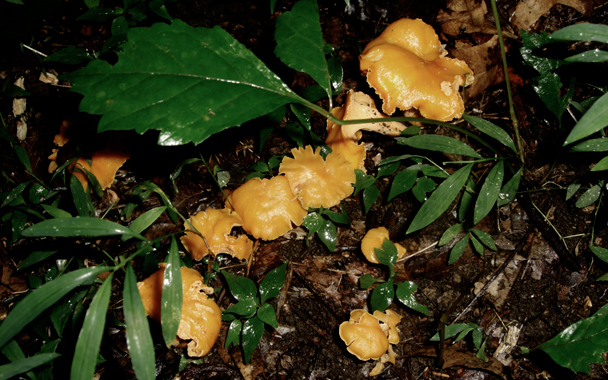By all accounts, foraging for mushrooms is a risky way to put food on the dinner table. Like riding a motorcycle at 90 miles an hour in the rain without a helmet, there’s an inherent danger, even when you know what you’re doing. For people like me, the danger is just part of the fun.
There are lots and lots of mushrooms that grow in the woods of Pennsylvania, and many of them are deadly. Some of them would only make you wish you were dead. And then, a few are totally delicious. Those are the mushrooms I like to find—the delicious ones that won’t make me vomit for six days, or worse, die. The real problem, I’ve found, is that those totally delicious mushrooms very often have poisonous look-alikes. I thought about this, briefly, last weekend, as I took an early morning wooded walk, in the rain.
Mushrooms, unlike tomatoes, enjoy nonstop rain. And, although it’s a little early in the year for fungus to really thrive, it has been so cool a summer that they’ve started to pop up anyway. Just ten minutes into the woods I came across a splattery Jackson Pollock–like scattering of fluorescent orange that seemed to intentionally cross my path. My heart jumped. Could these beauties be the elusive and prized Cantharellus cibarius? Chanterelles are one of the meatiest and most delicious mushrooms you can find, but they’ve got some sinister doppelgangers.
The most toxic of the chanterelle’s evil look-alikes is Omphalotus olearius, commonly known as the Jack-O-Lantern mushroom. Here are clues for identifying the Jack-O-Lantern:
1. The mushrooms grow in clusters with a common base.
2. They grow on rotting hardwood.
3. They have gills.
4. Here’s the real give-away: Those gills glow in the dark. It’s spooky.
If you find a cluster of these ’shrooms, take them into a room and turn off all the lights. Make sure it’s completely dark. Stare at the mushrooms. In a few minutes, your eyes will adjust and you’ll see the gills of the Jack-O-Lantern glowing a pale green. When you see this, turn on the lights, throw out the mushrooms and wash your hands. The Jack-O-Lantern probably won’t kill you if you eat it. It’s in that second category, the kind that will make you so sick that you just wish you were dead.
But if you’re lucky, like I was last weekend, you’ll find a patch of mushrooms with these features, indicating you’ve struck the chanterelle mother lode:
1. The mushrooms grow singularly or in groups of two.
2. They grow from the dirt (not on hardwood).
3. Instead of gills, they have what look like forked veins. (There’s a forager’s saying that goes, “True chanterelles have false gills; false chanterelles have true gills.”)
I picked the chanterelles and kept walking. In another 20 minutes, my basket was full of two pounds of bright orange mushrooms that smelled distinctly of apricots and pepper. When I got back to the farmhouse, it was time for breakfast. Deciding what to eat was pretty easy. Some of the best scrambled eggs in the world are those laced with meaty, fresh, aromatic chanterelles.
Now, a word to the wise: Unless you really know what you’re doing, you should neither pick wild mushrooms nor ride your motorcycle at 90 miles an hour in the rain without a helmet. To start to learn about the former, join a foraging club.


